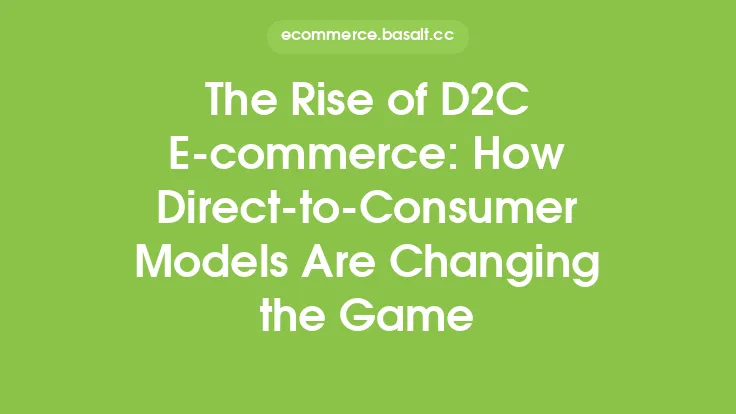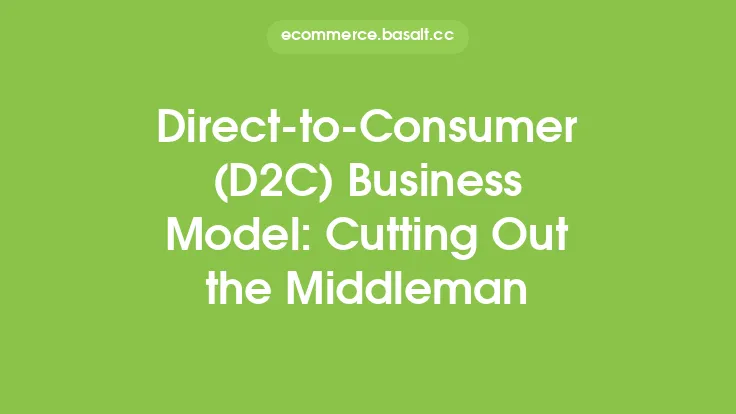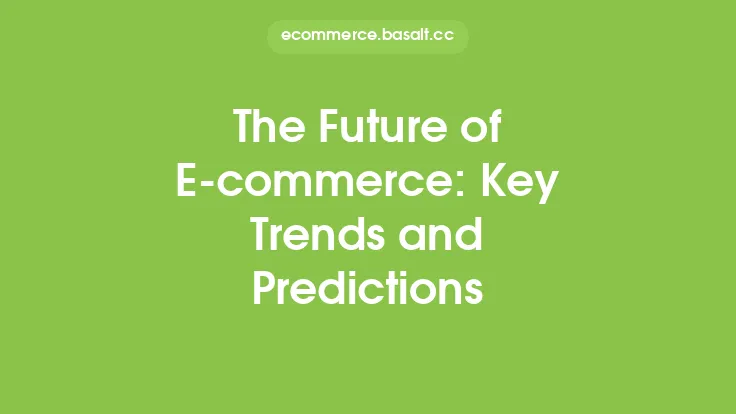The rise of e-commerce has led to a significant shift in the way businesses operate and interact with their customers. One of the most notable trends in e-commerce is the growth of direct-to-consumer (D2C) sales. This business model allows companies to sell their products or services directly to customers, bypassing traditional intermediaries such as wholesalers, distributors, and retailers. In this article, we will explore the concept of D2C sales, its benefits, and why it is considered the future of e-commerce.
What is Direct-to-Consumer Sales?
Direct-to-consumer sales refer to the practice of selling products or services directly to customers without the involvement of intermediaries. This can be done through various channels, including e-commerce websites, social media, online marketplaces, and physical stores. D2C sales allow companies to have complete control over the customer experience, from product development to delivery and customer support. This approach enables businesses to build strong relationships with their customers, gather valuable feedback, and create a loyal customer base.
Benefits of Direct-to-Consumer Sales
The D2C sales model offers several benefits to businesses, including:
- Increased profit margins: By eliminating intermediaries, companies can retain a larger share of the revenue generated from sales.
- Improved customer insights: D2C sales provide businesses with direct access to customer data, allowing them to gain a deeper understanding of their target audience's preferences, behaviors, and needs.
- Enhanced customer experience: Companies can design and deliver a personalized customer experience, from product development to customer support, to build strong relationships with their customers.
- Greater control over branding: D2C sales enable businesses to maintain control over their brand image, messaging, and overall customer experience.
- Faster time-to-market: By bypassing traditional intermediaries, companies can quickly respond to changes in the market and get their products to customers faster.
Key Characteristics of Successful Direct-to-Consumer Sales
To succeed in D2C sales, businesses must possess certain key characteristics, including:
- A strong brand identity: A well-defined brand image and messaging are essential for building customer loyalty and trust.
- A user-friendly e-commerce platform: A seamless and intuitive online shopping experience is critical for converting visitors into customers.
- Effective customer engagement: Businesses must be able to engage with their customers through various channels, including social media, email, and customer support.
- Data-driven decision making: Companies must be able to collect, analyze, and act on customer data to inform product development, marketing, and sales strategies.
- Agility and adaptability: The ability to quickly respond to changes in the market and customer preferences is essential for staying competitive in the D2C sales landscape.
Challenges and Opportunities in Direct-to-Consumer Sales
While D2C sales offer numerous benefits, there are also challenges and opportunities that businesses must be aware of, including:
- Increased competition: The D2C sales landscape is highly competitive, with many businesses vying for customer attention.
- High customer expectations: Customers expect a seamless and personalized experience from D2C brands, which can be challenging to deliver.
- Logistics and fulfillment: Managing logistics and fulfillment can be complex and costly, particularly for businesses that are new to D2C sales.
- Data privacy and security: Companies must ensure that they are collecting, storing, and using customer data in a responsible and secure manner.
- Opportunities for innovation: The D2C sales model provides opportunities for businesses to innovate and experiment with new products, services, and experiences.
The Future of Direct-to-Consumer Sales
The future of D2C sales looks promising, with the global D2C e-commerce market expected to continue growing in the coming years. As technology advances and customer expectations evolve, businesses must be prepared to adapt and innovate to remain competitive. Some of the key trends that are expected to shape the future of D2C sales include:
- The rise of social commerce: Social media platforms are becoming increasingly important for D2C sales, with many businesses using these channels to engage with customers and drive sales.
- The growth of influencer marketing: Influencer marketing is becoming a key strategy for D2C brands, which are partnering with influencers to promote their products and services.
- The importance of sustainability: Customers are increasingly expecting D2C brands to prioritize sustainability and social responsibility, which is driving innovation in areas such as packaging, shipping, and supply chain management.
- The role of artificial intelligence: Artificial intelligence is being used to personalize the customer experience, improve customer service, and optimize logistics and fulfillment.
Best Practices for Direct-to-Consumer Sales
To succeed in D2C sales, businesses must follow best practices, including:
- Know your customer: Understand your target audience's preferences, behaviors, and needs to deliver a personalized experience.
- Invest in e-commerce technology: A robust and user-friendly e-commerce platform is essential for providing a seamless customer experience.
- Focus on customer engagement: Engage with your customers through various channels to build strong relationships and drive loyalty.
- Collect and act on customer data: Use customer data to inform product development, marketing, and sales strategies.
- Prioritize sustainability and social responsibility: Customers expect D2C brands to prioritize sustainability and social responsibility, which is driving innovation in areas such as packaging, shipping, and supply chain management.
Conclusion
Direct-to-consumer sales are revolutionizing the way businesses operate and interact with their customers. By providing a personalized and seamless customer experience, companies can build strong relationships with their customers, drive loyalty, and increase revenue. As the D2C sales landscape continues to evolve, businesses must be prepared to adapt and innovate to remain competitive. By following best practices and staying ahead of the curve, companies can succeed in the D2C sales market and thrive in the ever-changing world of e-commerce.





